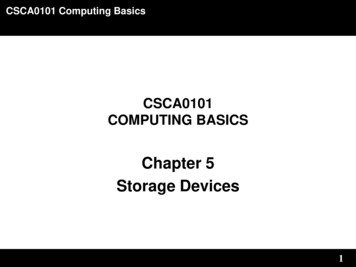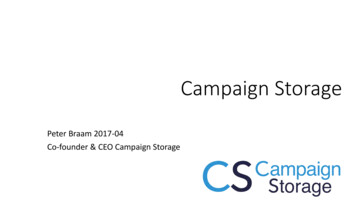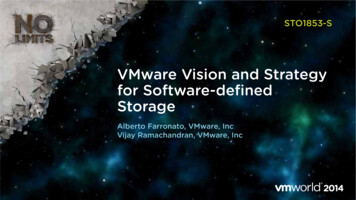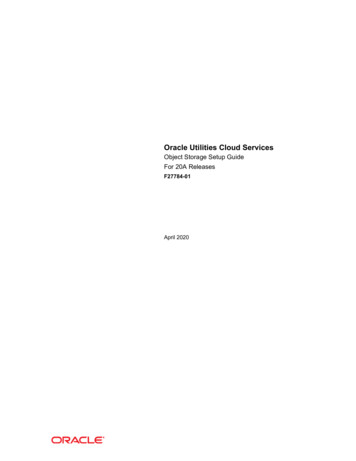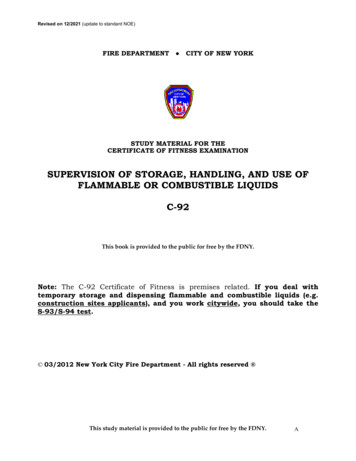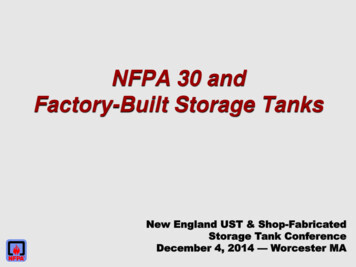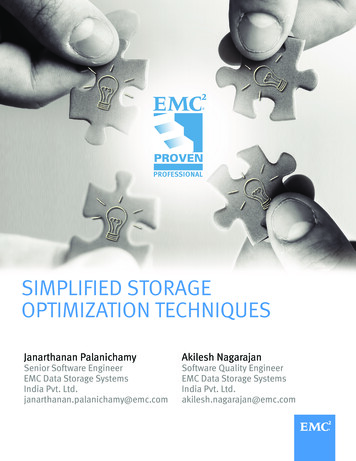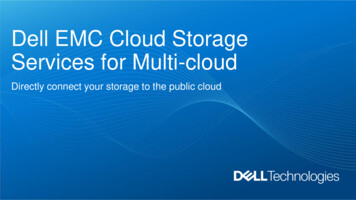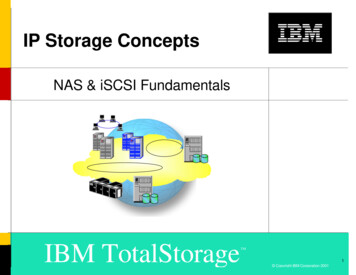
Transcription
IP Storage ConceptsNAS & iSCSI FundamentalsIBM TotalStorage IBM Corporation 2000. All rights reserved. CopyrightPresentation File Name1 Copyright IBM Corporation 2001
AgendaWhat Business Problem Needs to Be SolvedStorage Directions - Marketplace TrendsFundamental comparisons . NAS & SANNetwork Attached Storage (NAS) FundamentalsBenefitsSolutionsNAS Gateway FundamentalsBenefitsSolutionsiSCSI FundamentalsBenefitsSolutionsSummary IBM TotalStorage Copyright IBM Corporation 20012
Business ProblemEach server or client has its own dedicated storageStorage investment is tied to specific serverOnce server is replaced, storage investmentis lostMigration of data to new server & newstorage is requiredUnderutilized storage can not be shared byother servers or clientsData in storage can not be accessed by otherservers or clientsStorage must be managed as individualentitiesWindowsserverStorage100 GBsUNIXServerStorage100 GBsWebServerStorage100 GBsNovellServerStorage100 GBsDesktop,Workstation,ClientsStorage100 GBsNo centralized management or dataprotection IBM TotalStorage Copyright IBM Corporation 20013
Business SolutionPooled Storage on a network!Investment ProtectionStorage ConsolidationData Sharing and AccessHigh Utilization of storageWindowsserverStorage100 GBsUNIXServerStorage100 GBsWebServerStorageGBsStorage 100500GBsNovellServerStorage100 GBsStorage100 GBsHigh ScalabilityCentralized ManagementData ProtectionDisaster ToleranceDesktop,Workstation,ClientsProvides Ultimate Agility & Efficiency IBM TotalStorage Copyright IBM Corporation 20014
IP Storage NetworksFor all these reasons, IP networks may someday accommodatea large portion of the world's storage networking needsSpeeds of Ethernet networks are eclipsingFibre ChannelNetwork vs. I/O Speed10 Gbit ethernet on the horizon140Much more R&D is pouring into Ethernet thanFibreEthernet technology is less expensive thenFibre ChannelSwitches, Hubs, infrastructure, IT skillsIP is more prevalent than FCFC may be viable in large enterpriseenvironmentsBut needs substantial investmentNot viable in most other businessenvironments.small, midrange, departmental,workgroup, startup, emerging businessesTCP/IP inherently adds processing latency andrequires higher CPU cyclesData Rate MB/secGiga Group forecasts that IP based SANs willdominate (vs. Fibre Channel) in 5 to 7 years.120Source: HorizonInformation StrategiesxGigEFibre CSI100bt Switched20FDDI Shared10bt Shared019911994199720002003But higher engine processor speeds accommodatethe demand for increased CPU cycles IBM TotalStorage Copyright IBM Corporation 20015
Growth in Network Storage605072 % CGR NAS B403037 % CGR SAN201002000-11 % CGR Direct2001200220032004Source IDC 9/00 IBM TotalStorage Copyright IBM Corporation 20016
Two Types of Storage Networks1. Storage connected directly to IP Networks2. Storage connected directly to Fibre Channel Networks"Versus" may be giving way to "Convergence"One picks up where the other's weakness leaves off. IBM TotalStorage Copyright IBM Corporation 20017
Storage Network Comparison1. Network Attached Storage (NAS)Task-optimized, high performance storageappliance directly attached to IP networks,working independently of multipurpose serversproviding "File Serving" services to clients andservers in a heterogeneous environment2. Storage Area Network (SAN)High performance, dedicated storage networktailored to an environment, and combiningMultipurpose servers, storage products, networkingproducts, tape products, software & services.Stand-alone ApplianceComposite (Fabric) of several entitiesQuick to installLonger design & implementation timeRequires less IT skillsRequires higher levels of IT skillsOptimum Usage for File I/O operationsDesigned for Intensive Block I/OEthernet connections - TCP/IP protocolsFibre Channel - SCSI protocolsTypically less expensive ( /MB)Typically more expensive ( /MB)Performance & Scalability ConsiderationsHigh Performance & Massive ScalabilityStorageSANNAS - File ServerMultipurpose ServersIP NetworkIP Network IBM TotalStorage Copyright IBM Corporation 20018
File I/O vs. Block I/OFile I/OSometimes referred to as File-System protocols (NFS, CIFS.) Identifies data by file name and byte offsetTransfers file data or file metadata (files's owner, permissions,creation data, etc.) via TCP/IP protocolsHandles security, user authentication, file lockingBlock I/OSometimes referred to as raw disk or raw dataIdentifies data by disk block numberTransfers raw disk blocks via encapsulated SCSI protocols IBM TotalStorage Copyright IBM Corporation 20019
File-System vs. SCSI ProtocolsFile SystemFile-System protocols (also called "file I/O") are used for accessing and sharing data. Theprotocols are device independent. A file-system command might just request reading thefirst 80 characters from file "ABC", without knowing the location of the data on the device.Network File System (NFS)A file-system protocolNFS has its origins in the UNIX world.Common Internet File System (CIFS)Most often pronounced "siffs"A file-system protocolCIFS has its origins in the Microsoft NT worldSmall Computer Systems Interface (SCSI)SCSI is often called a "Block level" protocol or "Block I/O" because SCSI commandsspecify particular block (sector) locations on a specific disk.SCSI I/O commands tell disk devices to store and retrieve data from a specific location ona disk driveProtocol most prevalent in Storage Area Networks IBM TotalStorage Copyright IBM Corporation 200110
File Applications vs. Block ApplicationsNAS offers "File" application optimizationDesigned to work with File System applicationsTypical FILE I/OApplicationsFreelanceLOTUS 123Power PointWord ProLOTUS NOTESLotus Domino - ServerLotus ApproachVideoSAN's offers "Block" application optimizationThese applications are typically high performing andread and write large blocks of data directly to diskTypical BLOCK I/OApplicationsMicrosoft exchangeDB2InformixOracleVideo StreamingERP ApplicationsSupply ChainJD EdwardsLawson Software IBM TotalStorage Copyright IBM Corporation 200111
Everything is Stored on Disk in Block I/O via skBlock I/O via SCSINAS leSystemDiskFile I/OTransferred via TCP/IPDiskDiskBlock I/O via SCSI IBM TotalStorage Copyright IBM Corporation 200112
Network Attached Storage Concepts IBM TotalStorage Copyright IBM Corporation 200113
NAS Appliance CharacteristicsPreloaded file system (O/S) that provides file sharingWindows (CIFS), Unix (NFS), Web (HTTP), Novell.Storage Disk ArraysScales from GBs to TBsLANInstallation softwareManagement softwareData Protection TechnologyRAID ImplementationData Protection on DiskData Backup to TapeFile systemCIFS/NFS/HTTPDiagnosticsDiagnostic softwareRAID ControllerFault Tolerant FeaturesManagementNetwork Layer(TCP/IP)Quota & SecurityStorage Array(SCSI or FC disks )Dual, Redundant, Hot Swap ComponentsSelf Contained, Preinstalled, Preconfigured, Pretested at the Factory IBM TotalStorage Copyright IBM Corporation 200114
NAS. Main Operational CharacteristicsNAS is an optimized "File Server"Not a multipurpose or general-purpose serverDoes not replace multi/general purpose serversCannot install multi/general purpose applicationsFreelance, LOTUS 123, Power Point, Lotus Domino, ERP, DB2, Oracle, MicrosoftExchange.NAS typically serves files faster then multi/general purpose serversIt has a finely tuned operating system (O/S) for file servingIt has been freed from the latency and cycles of running multiple applications for other reasonsthan "file serving"NAS directly connects to an IP NetworkAll data enters and exits a NAS appliance via an IP Network in "File System Formats (File I/O)"NAS O/S internally converts the "File I/O" into "Block I/O Formats" and stores all data onto theintegrated disk arrays via SCSI commandsALL data, whether traversing NAS or Storage Area Networks (SAN) or Direct Attached Storage(DAS), is stored onto disks in "Block I/O Formats" via SCSI commands!NAS provides access to pooled storage with unlimited distance considerationSAN pooled storage is limited to fibre channel distance restrictions (100 km) IBM TotalStorage Copyright IBM Corporation 200115
NAS. Main Operational CharacteristicsNAS can talk several different "File System" languagesMost all NAS vendors supports:CIFS - Common Internet File SystemDeveloped by Microsoft for Windows ApplicationsNFS - Network File SystemDeveloped by Sun for UNIX ApplicationsOther protocols supported in NAS environmentsNetware (Novell), HTTP, FTP, MAC (Apple) .NAS allows multiple clients and servers in a mixed "File System" environment tostore and retrieve data on the same storage deviceNAS allows multiple clients and servers in a mixed "File System" to share eachothers dataThis is called "heterogeneous file sharing"NAS Appliances scale anywhere from GB's to TB's of storage capacityCurrent NAS designs have built-in performance & scalability limits whereas SANs generally donot IBM TotalStorage Copyright IBM Corporation 200116
Network Attached StorageSolution Scenarios IBM TotalStorage Copyright IBM Corporation 200117
NAS Solution .Server Consolidation withFile Sharing & BackupEnvision MediaEnvision Media, a 14 person advertising agency in Soquel CA, install the NAS devices last June to help solveseveral file access and storage issues.As part of its client services, Envision creates Web sites and portals. In addition, the agency runs a mixed shopof UNIX and Macintosh workstations for engineering, with business operations running applications stored onNT servers. The agency needed to share mixed files and currently with other clients.Envision's chief operating officer, recalls the agency was increasingly concerned about failures within theirgeneral-purpose servers and the shortage of available disk space.With no formal IT department, they looked for a simple solution capable of communicating with a variety ofdesktop platforms. They also needed a device that could serve as a temporary backup device or as anintermediate repository to store or access data, should a server go down.They chose a NAS solution. IBM TotalStorage Copyright IBM Corporation 200118
NAS Solution . Pooled Server Storage &File SharingCurrent EnvironmentSolutionDatabase andTransactionServers (UNIX)Database andTransactionServers (UNIX)DataCenter IPInfrastructureFile andApplicationServersDataCenter IPInfrastructureNASPooledStorageFile andApplicationServersNTNovell UNIXNTNovell UNIXBenefits:Higher availability and Backup (Disk Backup, Tape backup and RAID support)Pooled / Centralized StorageEasier and quicker to administer vs. other NT serversCentralized storage managementFile sharing and File synchronization IBM TotalStorage Copyright IBM Corporation 200119
NAS Solution .Web Server &Performance BoostUniversity of GeorgiaThe Information Technology Outreach Services (ITOS) arm of the University of Georgia in Athens,assists a variety of state and local agencies in creating, monitoring, and storing information for awide range of activities.To help gage the effectiveness of the states education system, for example, ITOS maintains a 35 GBdatabase that tracks the educational progress of every Georgia student from kindergarten through theworkforce. ITOS also helps create in-store hurricane tracking computer models, and produces andmaintains a repository for bandwidth hogging geographic information systems (GIS).To serve about 100 users working on 60 workstations, ITOS uses about 10 UNIX and Windows NTservers, the servers are connected to a 12 port 3Com gigabit switch which is in turn connected to theNAS server.Many ITOS employees using older UNIX workstations running software RAID experienced up to35 second-screen refreshes when working on the GIS maps. Offloading that data onto a NAS serverand away from the rest of the ITOS is server traffic caused refreshed time to drop to 5 seconds.Since it can communicate to workstations and other servers via NFS and CIFS protocols, the NASfile server bridged older and newer technologies. IBM TotalStorage Copyright IBM Corporation 200120
NAS Solution .HTTP File ServerCurrent ientsLANs,WANs,LANs,WANs,SAN(Fiber ritical,ServersSAN(Fiber Channel)Benefits:Offloaded SAN cyclesIncreased performance throughput (service level) to end usersMinimized investment in additional ServersProvided storage poolingProvided heterogeneous file servingUsed existing infrastructure / tools / processesIsolated Web clients away from "Mission Critical" data. SECURITY IBM TotalStorage Copyright IBM Corporation 200121
NAS Solution .Server ConsolidationNellis Air Force BaseAs a senior systems engineer at Nellis Air Force Base in North Las Vegas, the IT manager of a 5000 personscivil engineering (CE) squadron is responsible for designing, building, and maintaining everything on the basefrom sewer pipes to aircraft hangers.After building a small server farm following a migration away from a minicomputer, the IT manager and his ITstaff were able to consolidate and migrate to newer technologies, because the staff was spending too much timemanaging and adding capacity to older servers."I'm trying to simplify my job in an industry that has grown leaps and bounds beyond whatever we imagined,and the hardest thing for us to do is to keep up with the technology" (IT Manager).This manager choose a NAS solution which quickly scaled to serve files among divergent groups of engineersand builders. CAD/CAM data stored on NAS devices provides detailed maps illustrating all electrical, water,sewer, and telecommunications lines on the base. Accessing files directly over the network was importantbecause different user groups with different platforms required access to the same information.For example, if an engineer uses CAD/CAM program to produce and store roadway plans on the NAS device,workers preparing to dig can access the plans without reconfiguring their client machines to access a particularserver. As a result, this IT manager shaved a considerable amount of timeoff each project."A tangible NAS benefit is that it gives the IT person all the functionality of a standard server environment, butwithout the overhead of administration". According to this IT manager, "scaling capacity was one of the mosttime-consuming administrative duties and now if I need more capacity, I don't buy another server, a buy morecapacity and plug into my network. It only takes about 10 to 15 minutes of configuration." IBM TotalStorage Copyright IBM Corporation 200122
NAS Solution .File Server ConsolidationSolutionCurrent EnvironmentNovellUNIXNASFileServerNTW2KInternet / IntranetUNIXClientsNovell WindowsClients ClientsGeneral purpose OS serving filesviaFTP, CIFS, NFS, HTTP, Netware.Internet / IntranetUNIXClientsNovell WindowsClients ClientsGeneral purpose OS serving filesviaFTP, CIFS, NFS, HTTP, Netware.Benefits:Provided continuous availability to filesHeterogeneous file sharingReduced cost for additional OS dependent serversAdded storage capacity non-disruptivelyConsolidated storage managementLowered Total Cost of Ownership IBM TotalStorage Copyright IBM Corporation 200123
NAS Solution .Storage Consolidation,Data Protection & Temp WarehousingIsdaner & Co.With 50 workstations and a flea of remote laptop users running NetWare and Windows NT, the accounting firmof ISdaner & CO. LLC, in Bala-Cynwyd, PA, was running out of space on its Windows NT server.Already taxed with a slew of projects, the firm's three-person IT staff was concerned about having enough timeto install and configure another server, and users, and manage users licenses. Isdaner chose a NAS solution inlarge part because of low administration requirements."Administration is a big issue because there's literally a hundred other projects that our IS staff are involved in.Layering in more administration while attending to other high's needs of a growing office was not something wewanted to encounter" (IT Manager).An Isdaner & Co. policy mandates that laptop users take daily snapshot copies of their data while at a client site.Their NAS device proved useful as a data repository as accountants downloaded their data. Back in the office,employees now directly accessed remotely gathered information on the network without considerable time spentconfiguring menus and custom controls. IBM TotalStorage Copyright IBM Corporation 200124
NAS Solution .Storage Consolidation &Mission Critical Data ProtectionCurrent EnvironmentStorage for Networked ClientsSolutionStorage for Networked ClientsIP NetworkIP NetworkWindows, UNIX Family, NovellClientsNASPooledClientStorageWindows, UNIX Family, NovellClientsBenefits:Pooled / centralized storageEasier & quicker to administer vs. adding storage to each workstationProtected mission critical data with backup features (disk & tape)Higher availabilityFile sharing / file synchronization IBM TotalStorage Copyright IBM Corporation 200125
Network Attached Storage SummaryNAS is a high powered File ServerNAS offers pooled storage to clients and servers on an IP networkNAS allows multiple mixed "File System" clients and servers to access,retrieve and store data on the same storage deviceWindows, UNIX, Novell, HTTP, FTP.NAS allows heterogeneous file sharing to mixed clients and serversi.e.: Windows client can access a UNIX file and visa versaNAS DOES NOT replace multi/general purpose serversNAS offers a low Total Cost of Ownership propositionOperational, Administration, IT Skills, Storage (cost per GBs to TBs) IBM TotalStorage Copyright IBM Corporation 200126
NAS Gateway Concepts IBM TotalStorage Copyright IBM Corporation 200127
NAS Gateway Architectural CharacteristicsSAN vendors are starting to introduce NAS GatewaysLANNAS Gateways offer the same benefits &characteristics of NASConnects to IP networksPerforms as a File ServerHeterogeneous file sharingData ProtectionDiagnostic CapabilitiesClustering & failover featuresFile systemCIFS/NFS/HTTPDiagnosticsNAS Gateway is a NAS Appliance with one exceptionRAID ControllerNAS Gateways supports direct attachment to FC storage orconnection to a storage devices across a SAN - NAS Gateways donot have any integrated disks for data storageManagementNetwork Layer(TCP/IP)Storage Array(SCSI or FC disks )Fibre Channel PCI PortSome NAS Gateway designs offer multipleconnectivity optionsRAID ControllerFC switches, hubs, directors, RAID controllers and disk arraysStorage Array(SCSI or FC disks )SAN IBM TotalStorage Copyright IBM Corporation 200128
NAS Gateway ConsiderationsQuestions to ask when connecting remote servers to a SAN:What are the distance considerations?FC connectivity has distance limitations (100 km or less)IP connectivity offers unlimited distance supportIs the cost of a FC PCI Adapter (per Server) and FC Switch/Hub cost effective?Cost of a FC PCI Adapter 2000 (approx.)Cost of a FC port on switch/hub/director 3000 (approx.)Redundancy paths double the connection costsMany times, FC connection costs exceed the value of the ServerEthernet connection costs are significantly lessDo you need Heterogeneous file sharing/serving?Does the environment have a mix of UNIX, NT, Novell Clients and Servers?NAS devices support heterogeneous file sharing IBM TotalStorage Copyright IBM Corporation 200129
NAS Gateway Solution ScenarioWhy purchase additional integrated NAS storage when you alreadyhave SAN storageCapitalize on your storage investment and purchase NASfunctionality without the cost of additional NAS storageFC has distance limitationsFC is costly to deploy whencompared to cost ofdepartmental or workgroupclass serversorNTIP NetworkNASGatewayMultipurpose UNIXServersMix of UNIX & NT ServersStorageAreaNetworkFC Switch or HubDiskDiskDiskDiskDisk IBM TotalStorage Copyright IBM Corporation 200130
NAS Gateway SummaryGives you the combined benefits of NAS and SANSAN scalability and performanceNAS flexibility and ease of useIncreases the reach of SAN infrastructureExtends beyond topology limitations of fibre channelProvides IP device access to SAN storageLeverages the value of SAN investmentReduces access costsAllows access to underutilized SAN storageEnables heterogeneous file serving IBM TotalStorage Copyright IBM Corporation 200131
iSCSI Concepts IBM TotalStorage Copyright IBM Corporation 200132
iSCSI IntroductioniSCSI (SCSI over IP)New and emerging technologyProvides routing of SCSI protocol over IP networksStandards BasedIETF - Internet Engineering Task isci-06.txtPrior to iSCSI there was no standardized method to transport "Block I/OFormats" over IP networksClients and Servers wanting to store data on LAN connected storagedevices (NAS) were required to transport the data in File I/O formats(CIFS, NFS.)Added additional layers of latency IBM TotalStorage Copyright IBM Corporation 200133
Facts . could iSCSI be important?iSCSI can enhance and compliment IP Storage solutionsRemember, all data, whether traversing NAS or SAN or DAS, is stored ontodisk drives in "Block I/O Formats" via SCSI commandsOnly standardized method for storing data over IP networks is in "FileSystem" formatsPrior to iSCSI standardsiSCSI reduces a layer of latencyEliminates the need for "block I/O" conversion to "File I/O" before transmission over IP network IBM TotalStorage Copyright IBM Corporation 200134
What's the Immediate Benefit of iSCSI?Data Base Management Systems (DBMS) applications are designed to run in ablock-oriented environmentThese high performance applications do not need universal access, from manyenvironments, at the file level (like NAS). They care more about block level performanceand controlDBMS applications demand direct connection to storage via Block I/O SCSI formats.Consider that DBMSs are constrained with File I/O based access to storage (like NAS)Example: If you are using SQL with NAS, the "Block I/O" needs to be converted to "File I/O", transportedover IP network, deconverted from "File I/O" into Block I/O and stored on diskThis process creates enormous latency.In order for high performance applications to interact with remote storage (connected viaa LAN), the need to reduce latency is criticaliSCSI . a step in the right direction. IBM TotalStorage Copyright IBM Corporation 200135
iSCSI SolutionsiSCSI solutions are currently available in two deliverables1. iSCSI ApplianceTotally integrated with Storage and Server combined into one entityLooks like a NAS device but does "block I/O" on IP network via iSCSIprotocols vs. "file I/O" on IP network via File System protocols2. iSCSI GatewayAccess to Storage Area Network or RAID StorageLooks like a NAS Gateway device but does "block I/O" on IP networkvia iSCSI protocols vs. "file I/O" on IP network via File SystemprotocolsiSCSI ApplianceiSCSIClientSoftware1IP NetworkiSCSITargetSoftwareiSCSI GatewayiClient (initiator) code routesSCSI commands over IP network2.iSCSI target code receives SCSIcommands from IP network2DASSCSI Protocol1.SAN IBM TotalStorage Copyright IBM Corporation 200136
iSCSI Pooled Storage ConsolidationSolutionCurrent environmentData center IPinfrastructureData center IPinfrastructureHigh- performancedatabase and transactionserversblock I/O or non-sharedenvironmentHigh- performancedatabase and transactionserversblock I/O or oled/centralized storageNon-disruptive growthCentralized storage managementUtilized existing network/IP skills IBM TotalStorage Copyright IBM Corporation 200137
Ethernet vs. Fibre Channel AlternativeCurrent OptionAlternative se applicationsblock I/ODatabase applicationsblock I/OEthernetFibre ChanneliSCSIpooledstorageStorageBenefits:Provides pooled storage to high performance database, applicationsUses existing infrastructure/tools/processesRequires fewer IT skillsRequires minimum investment IBM TotalStorage Copyright IBM Corporation 200138
Positioning iSCSI and NASIf Primary Benefactor End UsersAnd If Primary Need is Sharing FilesNASIf Primary Benefactor End UsersAnd If No Need to Share FilesiSCSIIf Primary Benefactor Server App.iSCSIIf Primary Benefactor Server App.And If Need to Share FilesNASIf FC isn't realistically an optionCombination NAS & iSCSIAppliance IBM TotalStorage Copyright IBM Corporation 200139
Credits, Acknowledgments & Disclaimers Copyright International Business Machines Corporation 2001IBM CorporationPO Box 12195Research Triangle Park NC 27709U.S.A.06-01All Rights ReservedReferences in this presentation to IBM products or services do not imply that IBM intends to make them available in allcountries in which IBM operates.All information being released represents IBM corporation's current intent, goals and/or objectives, and is subject to changeor withdrawal without notice.The performance data contained herein was obtained in a controlled environment based on the use of specific data. Actualresults that may be obtained in other operating environments may vary significantly. These values do not constitute aguarantee of performance.IBM, the IBM logo, Netfinity, Predictive Failure Analysis, and ServeRAID are trademarks of International Business MachinesCorporation in the United States, other countries or both.Tivoli is a trademark of Tivoli Systems, Inc. in the United States or other countries or both.Intel and Pentium are trademarks of Intel Corporation in the United States, or other countries, or both.Microsoft, Windows, Windows NT, and the Windows logo are trademarks of Microsoft Corporation in theUnited States, other countries, or both.UNIX is a registered trademark of The Open Group in the United States and other countries.Other company, product and service names may be trademarks or service marks of other companies. IBM TotalStorage Copyright IBM Corporation 200140
1. Network Attached Storage (NAS) Task-optimized, high performance storage appliance directly attached to IP networks, working independently of multipurpose servers providing "File Serving" services to clients and servers in a heterogeneous environment 2. Storage Area Network (SAN) High performance, dedicated storage network
